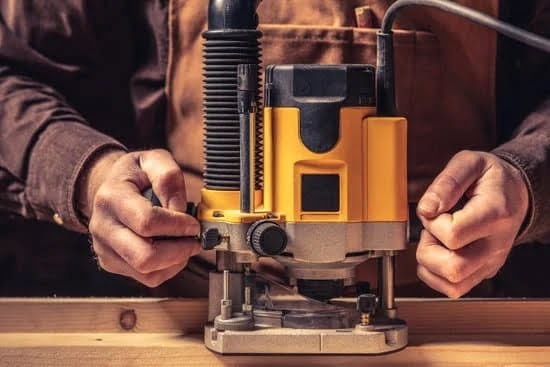Introduction
Woodworking is a beautiful craft that can create unique and useful items while allowing the woodworker to express their creativity. Woodworking projects offer a sense of pride, achievement, and skill development. Working with wood can also become an enjoyable hobby or even provide money-making opportunities. To get started in the wonderful art of woodworking, there are some basic tools needed for many types of projects.
The first thing needed when starting out with any woodworking project is knowledge. Educating yourself on different kinds of woods, joining techniques, and proper maintenance will help ensure success on your project. Researching as much information about the intended project as possible is essential towards creating a successful outcome.
The second step is having the correct tools for the job. While many tools require precision and skill to use, having the right tool suitable for specific tasks can save time, effort and produce better finished results. Here are some of the most common tools used in woodworking:
• Circular saw: Ideal for straight slicing tasks while offering power and speed to cut thick pieces of wood easily;
• Jigsaw: Useful tool for making curved cuts;
• Hammer: Used to fasten wood together by driving nails and pegs;
• Chisel: Essential for cutting through even hardwoods;
• Drill Press: Perfect solution when needing to make holes in different woods;
• Router Table: An especially versatile tool for shaping edges accurately;
• Sander or Plane: Allowing you to smoothen surfaces quickly and efficiently;
• Hand Plane: Great for fine-tuning detailed work around bevels or contours;
• Wheel Marking Gauge: Primarily used to mark out lines precisely around corners or edges;
• Clamp: Provides secure compression while assembling parts together properly;
• Square/Combination Square Tool: Especially useful when checking angles or joints which need square cuts.
In conclusion, using knowledge obtained through research combined with the correct tools necessary for executing a desired end result leads us closer towards becoming true masters at our craft!
Essentials
Circular saws: Circular saws are one of the most versatile and widely used tools for woodworking. They can be used to make straight cuts, rip lumber, create beveled edges, and more. When using a circular saw, make sure it is properly maintained with sharp blades and well-oiled parts. For safety, always wear eye and ear protection when operating a saw.
Table Saw: A table saw is one of the best investments a woodworker can make since it provides greater control over larger boards and makes precise angled cuts with ease. It’s important to learn how to use the saw safely when making multiple rips or performing cross-cuts on longer pieces. Be sure to maintain your table saw with regular cleanings and lubrications; otherwise you run the risk of damaging the motor or other parts of the machine.
Router: Routers are excellent tools for drilling very intricate shapes and grooves in wood. It’s essential to understand which bits will work best for each job you do, as well as use sharp ones for more accurate results that don’t require too much effort from you. Also make sure you keep your router securely fastened in a router table or other stand so that it stabilizes firmly as you work.
Drill: Drills offer amazing speed, accuracy and power when it comes to creating holes in various materials, from soft woods like pine to hardwoods like oak or walnut. Make sure you always use sharp drill bits for each job and wear safety glasses at all times when using power drills to avoid dust particles flying into your eyes. Additionally, never hold objects in your hand while drilling; it’s best to use clamps or jigs instead for precision results every time!
Hand Tools Primer
Hand tools are essential for any woodworking project, and they can come in many shapes and sizes. An essential hand tool list should include such items as a claw hammer, adjustable pliers, blades, chisels, screwdrivers, drill/driver sets, mallets/hammers, saws (jab, coping, crosscut and dovetail), measuring tools (tape measurer and calipers), squares/levels (miter or combination square), planers (straight and belt) sanders (orbital or belt), clamps (C-clamps and bar clamps) dowels jigs, planes (shoulder planes), files, vices and lastly but not least an angle grinder.
Each of these tools have their own specific purposes when it comes to working on wood projects. A claw hammer is generally used to drive nails while the adjustable pliers allow you to adjust the pivot point on screws or bolts. Blades come in varies sizes for cutting different shapes or pieces of wood. Chisels are best used for shaving down a piece of wood into whatever shape you desire. Screwdrivers are one of the more common tools as they can fasten together two pieces of material quickly. Drill/drivers can be used to make precise holes in wood when driving in screws with a screwdriver isn’t enough. Mallets/hammers are great for knocking pieces of wood into place without damaging them from too much force from your bare hands.
Saws play an important role in crafting the perfect piece of furniture as using the wrong saw could cause irreparable damage depending on what type is being used for that particular job. Using a tape measurer will help you get accurate measurements each time while calipers come standard in most general workshops as they offer precision measurements within smaller increments than inches or centimeters could provide individually. Planes provide long strips and boards greater accuracy while files help to smooth out any rough edges. Dowels assist with joint making while jigs offer extra support if needed during curious angles or cuts that may require an extra level of stability than what could be provided manually by yourself.
Clamps are necessary when undertaking almost any carpentry job that requires precise measurements or accuracy as they hold objects securely in place which is especially helpful when constructing larger items where parts must remain firmly attached even if adjustments need to be made further up the process chain from where the clamp was originally installed into position initially before production began advancing onward at large towards its completion date exponentially sooner than previously anticipated smoothly with no hitches whatsoever thankfully significantly reducing labor costs overall in the long run surprisingly across all sectors universally properly generating successive positive growth economically heading into a better direction by design eventually thus benefiting everyone externally nowadays conveniently leading everyone involved exponentially closure towards that inevitable utopian age ahead eagerly awaiting our arrival joyously welcoming us home finally once again when we arrive charmingly together afterward afterwards just like we’ve never left before yet still nicely amazed mindfully over-joyed spiritually internally now apparently duly accordingly wonderfully indubitably beautifully gloriously mercifully thankfully equanimously altogether benefitting all parties concerned congruently harmoniously favorably totally blazing brightly brightly positively positively positively positively poetically!
Specialty Tools
Chisels: Chisels are tools used to create and shape wood. They come in different sizes and shapes, depending on the job they are intended to do. Chisels are useful for cutting and shaping intricate details, beveling edges, creating grooves and channels, as well as for splitting joints. The benefits of chisels include increased accuracy when working on complicated projects.
Cordless Drills: Cordless drills offer access to areas where a traditional corded drill may not reach. In addition, this tool allows for greater speed and convenience when drilling into wood surfaces. The benefits of a cordless drill include improved mobility and faster work over large sections of woodwork.
Routers: Routers are an indispensable tool for many types of projects requiring precision shaping of edges or detailed carving into different types of wooden items. Some routers can also be fitted with special templates that allow users to make various cuts in one pass without having to adjust the machine multiple times. The benefits of using a router include uniformed chips and dust across the entire length of cutouts, which significantly reduce sanding time afterwards.
Resources
Having the right tools for woodworking can make all the difference in getting your projects done quickly and effectively. Below is a comprehensive list of essential supplies and resources you need to purchase or borrow for any woodworking project.
1) Workbench: A sturdy workbench is an absolute necessity for any successful woodworker. A good workbench should provide plenty of table-top space, storage space underneath, and adjustable height capabilities so that it can be adapted to the size of the person who’ll be using it.
2) Saws: You will inevitably need to cut materials when working with wood, so having a range of different types of saws at your disposal is advantageous. Popular varieties include rip saws, crosscut saws, backsaw, coping saws and miter saws.
3) Clamps: Clamps are also indispensable since they help hold pieces together while you work on them safely and securely. C-clamps, F-clamps, pipe clamps, web clamps and spring clamps are among the assortment commonly used in woodworking projects.
4) Chisels & Planes: Chisels & planes are necessary for fine tuning shapes, nuances or decorative details in your finished product. Be sure to invest in a few quality chisels & planes with varying blade sizes for maximum versatility in tightening up cut pieces of wood or planing down surfaces from rough cuts to even out edges & sides before assembly.
5) Drilling/Installation Equipment: In addition to handsaws (& drill presses when needed), one will also require a selection of drill bits such as spade bit drills & masonry bit drills as well as installation devices like nail guns & glue guns (for larger projects). Various other smaller items such as sandpaper and whetstones may also prove helpful along the way depending on what type of project you’re embarking on.
Safety
A few safety considerations that you should consider when using woodworking tools and power equipment include: always wear enclosed shoes and other protective gear such as designed eye protection and respirator; use sharp tools properly to reduce the risk of kickback or tool breakage, never force the tool, let it do its own job; disconnect from power sources before making any adjustments such as switching blades or changing settings. Always make sure your work area is free from clutter to help eliminate slipping hazards. Be aware of any cords around your workspace—take precautions to ensure they are out of your way. For additional safety, keep all tools away from children and pets. Check for loose screws or missing blades on saws and sanders prior to every use. Taking these precautions will help you have a safe working environment for yourself and others in the vicinity.
Tips
If you’re a woodworking enthusiast, having the right tools is key to your success. Here is a list of must-have tools to get started in woodworking:
• Hand saw – This versatile tool is essential for making cuts in all kinds of wood. Depending on the project you’re working on, choosing the right hand saw may be crucial.
• Chisels – Chisels are essential for cutting, shaping and smoothing out edges, grooves and other detailing work on wooden projects. Choose smaller chisels for fine detailing work and larger chisels for wider projects.
• Hammer – A hammer is an essential tool when it comes to driving nails through pieces of wood or metal. You should make sure you use the correct type of hammer for the job since different hammers have different head types, such as ball peen or flat face.
• Drill – Drills are helpful when it comes to making holes in wood. This makes drilling pilot holes easier when working with screws and other hardware, as well as countersinking screw heads into wood surfaces so they can be flush with their surroundings.
• Sandpaper – Sandpaper is great for sanding down rough surfaces that are exposed after cutting and shaping, whether by hand or machine tools like routers. Generally speaking, finer grits (such as 220) are used for finishing work, while courser grits (such as 80) are useful for removing material quickly from larger areas of surface area.
• Router – Routers can help create intricate shapes and decorative designs in wood, while also allowing you to reshape edges given enough time and patience. Be careful whatever router you choose; power routers have more power than traditional hand-routed ones, but require more skill and concentration while operating them safely.
• Clamps – Clamps provide extra tension to hold parts together securely during assembly work that cannot be joined by nails or screws alone due to their size or positions relative to one another.
Conclusion
This article has given a comprehensive list of tools for woodworking, covering both the power and hand-powered tools required to complete a variety of projects. By having these tools in your arsenal, you’re able to complete all kinds of detailed carpentry or do-it-yourself projects. Power tools such as drills, saws, routers, and sanders will give you precision and speed on larger jobs, while hand tools like chisels and scrapers are excellent for precise work with delicate materials. Furthermore, tools like clamps and vises can hold materials in place for easy assembly or adjustment.
In conclusion, having the right tools for woodworking is key to successful project completion; it pays off to take some time researching what kind of tools best suit your needs. With the right set of power and hand-powered tools in your toolbox, you’ll have a better chance of tackling everything from minor repairs to large renovations with ease and efficiency. So go grab that sawdust bin – it’s time to get woodworking!

Hi everyone! I’m a woodworker and blogger, and this is my woodworking blog. In my blog, I share tips and tricks for woodworkers of all skill levels, as well as project ideas that you can try yourself.





